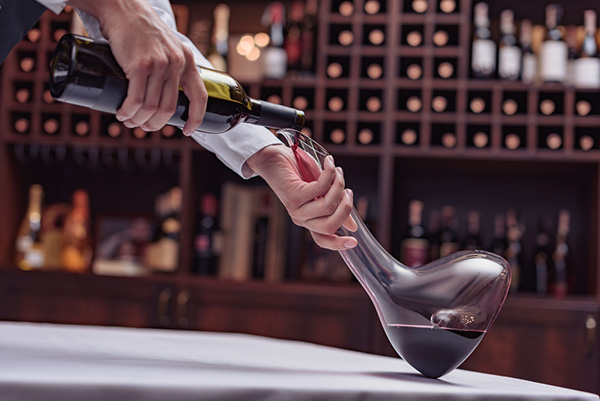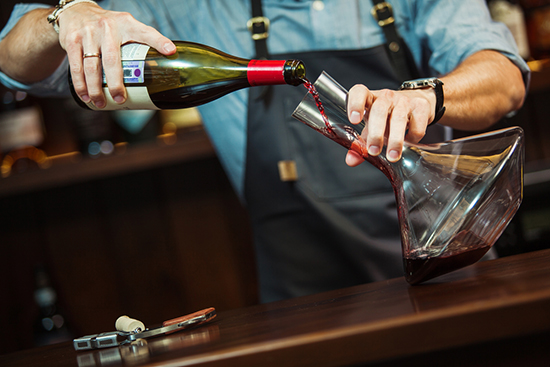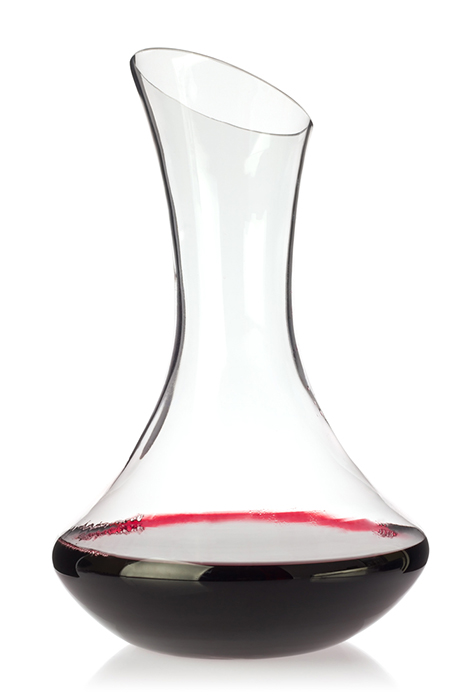How to Decant Wine: A Complete Guide to Wine Decanting

Decanting is a practice that has been around for centuries, often associated with the world of wine but also with liquors like whiskey and cognac.
In this guide, we break down decanting into simple terms.
Find out which wines need to be decanted, how to decant wine and how long to do it for.
When you’re finished you’ll know as much about decanting wine as a sommelier.
What is Decanting?
Decanting is the process of pouring wine from its original bottle into a separate container, called a decanter, to allow the wine to breathe and develop its flavors.
This process serves two main purposes:
- 1To separate the wine from any sediment that has formed.
- 2To aerate the wine, allowing it to “open up” and reveal its true character.
But what is this sediment? And why does some wine like to be aerated? Let's find out.

Why Decant Wine?
Let's dig a bit deeper into the reasons for decanting wine.
Reason #1: Separating Sediment
Over time, especially in the case of older wines, sediment can form at the bottom of the bottle.
This sediment is harmless but it can negatively affect the texture and taste of the wine if not separated.
It consists of insoluble bits of grape skin and pulp, as well as dead yeast cells.
Decanting allows you to pour the clear wine into a new container, leaving the sediment behind in the original bottle.
Decanting wine to separate sediment can take a bit of skill and patience as the quality of the job is all down to your steadiness of hand. We'll find out how down below.
Reason #2: Aeration
Aerating the wine exposes it to oxygen, which can help soften tannins, round out flavors, and enhance the aromas.
This process is particularly beneficial for young, full-bodied red wines, as it allows their complex flavors and characteristics to develop more quickly than they would through simple bottle aging.
But be aware that aeration isn’t always beneficial to a wine and I’ll cover these instances in the next section.
Which Wines Benefit from Decanting?
Exposing a wine to oxygen is not always a good thing so it's important to know the situations when decanting is necessary and when it should be avoided.
Wines to Decant
Wines Not to Decant

How to Decant Wine
- 1Choose the right decanter: A good decanter should have a wide base to maximize the surface area of the wine exposed to oxygen. This will ensure that the wine aerates effectively. You can see my decanter of choice in my 'Wine Essentials' guide.
- 2Allow the wine to rest: Before decanting, let the wine bottle sit upright for a few hours, allowing any sediment to settle at the bottom.
- 3Remove the foil and cork: Carefully cut the foil around the lip of the bottle and remove the cork, ensuring not to disturb any sediment. Two pronged corkscrews like The Durand are best for removing particularly old and fragile corks.
- 4Pour the wine into the decanter: With a steady hand, slowly pour the wine into the decanter, keeping an eye on the neck of the bottle for any sediment. A light source, like a candle or flashlight, can help you see any sediment more clearly. Stop pouring once you notice sediment approaching the neck of the bottle.
- 5Let the wine breathe: Allow the decanted wine to sit for a while, typically 30 minutes to 2 hours, depending on the wine (see below for decanting times). This will give the wine enough time to aerate and develop its flavors. Some wines may require more time, while others may need less. Trust your instincts and taste the wine periodically to determine when it's ready to be served.
- 6Serve the wine: Once the wine has reached its optimal flavor and aroma development, it's time to serve and enjoy. Pour the wine into appropriate glassware (check out my favorite glasses here) and savor the enhanced taste and bouquet that decanting has brought forth.

How Long Do You Decant Wine For?
The ideal decanting time can vary depending on the specific wine, its age, and its structure.
Here are some general guidelines for decanting different types of wines:
Medium-Bodied Reds
Examples include Merlot, Grenache, and Sangiovese. These wines typically benefit from around 30 minutes to 1 hour of decanting. This allows enough time for the wine to aerate and develop its flavors without losing its fruitiness or freshness.
Full-Bodied Reds
Examples include Cabernet Sauvignon, Syrah, Malbec, and Bordeaux blends. These wines often have more tannins and can benefit from a longer decanting time, ranging from 1 to 3 hours.
Decanting allows the tannins to soften and the complex flavors to develop, resulting in a smoother, more enjoyable wine.
Older Red Wines
Aged red wines, especially those with more than 10 years of age, can be more delicate and require a shorter decanting time, typically around 30 minutes to 1 hour.
The main purpose of decanting older wines is to separate the wine from any sediment that may have formed during aging, rather than to aerate the wine.
Light-Bodied Reds and Whites
Light-bodied red wines, like Pinot Noir and Beaujolais, as well as most white wines, typically don't require decanting.
However, if you feel the wine could benefit from aeration, a brief 15 to 30-minute decant can help open up the flavors and aromas.
Bold, Oaky White Wines
Some full-bodied white wines, such as oaked Chardonnay, can benefit from decanting, especially if they're young.
Decant these wines for 30 minutes to 1 hour to allow the flavors to integrate and the oak influence to mellow.
Orange Wines
Orange wine is essentially white wine made with extended skin contact during fermentation and it can benefit from decanting in certain cases.
Decanting an orange wine can help to open up its complex flavors and aromas, as well as soften any tannins or astringency that may be present due to the skin contact.
However, not all orange wines need decanting. Lighter, more delicate orange wines might not require decanting, while more robust and structured examples could benefit from some aeration.
If you choose to decant an orange wine, a general guideline would be to decant it for about 30 minutes to 1 hour.
As with any other type of wine, it's a good idea to taste the wine periodically as it decants to determine when it has reached its optimal expression.
Remember that these are just general guidelines, and the optimal decanting time can vary for each specific wine.
It's always a good idea to taste the wine periodically as it decants to determine when it has reached its peak.
Tips for Decanting Wine
Decanting wine is an essential technique for wine enthusiasts, allowing you to fully appreciate and enjoy your wine to its fullest potential.
By understanding why, when, and how to decant, you'll be able to enhance your wine experience and impress your friends and family with your knowledge and skill.
So, the next time you open a bottle, consider decanting and savor the difference it can make.
Any questions? Leave a comment down below and I'll get back to you promptly!

Thank you for this excellent website about wine. I am learning a lot from it. I have a question about decanting temperature. You recommend decanting at the appropriate serving temperature. Do you put the decanted wine into a refrigerator? How do you get the wine to or maintain the wine at serving temperature while decanting?
Thanks!
Rg
Hi Rodney,
Thanks for your kind words, we appreciate it!
It really depends on how warm the room is. I think most reds are best served approaching 65 degrees F. But, yes it’s perfectly acceptable to put the decanter on ice or even in the fridge. Another solution is to have the wine chilled slightly ahead of decanting. After a few tries you’ll learn how chilled the wine must be to reqch serving temperature after say an hour of decanting.
Hope this helps!
Tim